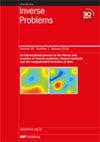A structured L-BFGS method and its application to inverse problems
IF 2
2区 数学
Q1 MATHEMATICS, APPLIED
引用次数: 0
Abstract
Many inverse problems are phrased as optimization problems in which the objective function is the sum of a data-fidelity term and a regularization. Often, the Hessian of the fidelity term is computationally unavailable while the Hessian of the regularizer allows for cheap matrix-vector products. In this paper, we study an L-BFGS method that takes advantage of this structure. We show that the method converges globally without convexity assumptions and that the convergence is linear under a Kurdyka–Łojasiewicz-type inequality. In addition, we prove linear convergence to cluster points near which the objective function is strongly convex. To the best of our knowledge, this is the first time that linear convergence of an L-BFGS method is established in a non-convex setting. The convergence analysis is carried out in infinite dimensional Hilbert space, which is appropriate for inverse problems but has not been done before. Numerical results show that the new method outperforms other structured L-BFGS methods and classical L-BFGS on non-convex real-life problems from medical image registration. It also compares favorably with classical L-BFGS on ill-conditioned quadratic model problems. An implementation of the method is freely available.结构化 L-BFGS 方法及其在逆问题中的应用
许多反演问题被表述为优化问题,其中的目标函数是数据保真度项和正则化项之和。通常情况下,保真项的 Hessian 无法计算,而正则化的 Hessian 可以实现廉价的矩阵向量乘积。在本文中,我们研究了一种利用这种结构的 L-BFGS 方法。我们证明了该方法无需凸性假设即可全局收敛,并且在 Kurdyka-Łojasiewicz 型不等式下收敛是线性的。此外,我们还证明了在目标函数为强凸性的聚类点附近的线性收敛。据我们所知,这是首次在非凸环境中建立 L-BFGS 方法的线性收敛性。收敛性分析是在无限维的希尔伯特空间中进行的,这对逆问题是合适的,但以前从未做过。数值结果表明,在医学图像配准的非凸实际问题上,新方法优于其他结构化 L-BFGS 方法和经典 L-BFGS。在无条件二次模型问题上,新方法也优于经典 L-BFGS。该方法的实现可免费获取。
本文章由计算机程序翻译,如有差异,请以英文原文为准。
求助全文
约1分钟内获得全文
求助全文
来源期刊

Inverse Problems
数学-物理:数学物理
CiteScore
4.40
自引率
14.30%
发文量
115
审稿时长
2.3 months
期刊介绍:
An interdisciplinary journal combining mathematical and experimental papers on inverse problems with theoretical, numerical and practical approaches to their solution.
As well as applied mathematicians, physical scientists and engineers, the readership includes those working in geophysics, radar, optics, biology, acoustics, communication theory, signal processing and imaging, among others.
The emphasis is on publishing original contributions to methods of solving mathematical, physical and applied problems. To be publishable in this journal, papers must meet the highest standards of scientific quality, contain significant and original new science and should present substantial advancement in the field. Due to the broad scope of the journal, we require that authors provide sufficient introductory material to appeal to the wide readership and that articles which are not explicitly applied include a discussion of possible applications.
 求助内容:
求助内容: 应助结果提醒方式:
应助结果提醒方式:


